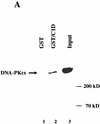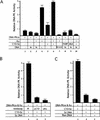DNA end-independent activation of DNA-PK mediated via association with the DNA-binding protein C1D
- PMID: 9679063
- PMCID: PMC317006
- DOI: 10.1101/gad.12.14.2188
DNA end-independent activation of DNA-PK mediated via association with the DNA-binding protein C1D
Abstract
DNA-dependent protein kinase (DNA-PK), which is involved in DNA double-strand break repair and V(D)J recombination, is comprised of a DNA-targeting component termed Ku and an approximately 465-kD catalytic subunit, DNA-PKcs. Although DNA-PK phosphorylates proteins in the presence of DSBs or other discontinuities in the DNA double helix in vitro, the possibility exists that it is also activated in other circumstances via its association with additional proteins. Here, through use of the yeast two-hybrid screen, we discover that the recently identified high affinity DNA binding protein C1D interacts with the putative leucine zipper region of DNA-PKcs. Furthermore, we show that C1D can interact with DNA-PK in mammalian cells and that C1D is a very effective DNA-PK substrate in vitro. Finally, we establish that C1D directs the activation of DNA-PK in a manner that does not require DNA termini. Therefore, these studies provide a function for C1D and suggest novel mechanisms for DNA-PK activation in vivo.
Figures














Similar articles
-
Induction of apoptosis by overexpression of the DNA-binding and DNA-PK-activating protein C1D.J Cell Sci. 1999 Jul;112 ( Pt 13):2223-32. doi: 10.1242/jcs.112.13.2223. J Cell Sci. 1999. PMID: 10362552
-
DNA-dependent protein kinase phosphorylation of IkappaB alpha and IkappaB beta regulates NF-kappaB DNA binding properties.Mol Cell Biol. 1998 Jul;18(7):4221-34. doi: 10.1128/MCB.18.7.4221. Mol Cell Biol. 1998. PMID: 9632806 Free PMC article.
-
DNA-PK-dependent phosphorylation of Ku70/80 is not required for non-homologous end joining.DNA Repair (Amst). 2005 Aug 15;4(9):1006-18. doi: 10.1016/j.dnarep.2005.05.003. DNA Repair (Amst). 2005. PMID: 15941674
-
The DNA-dependent protein kinase, DNA-PK: 10 years and no ends in sight.Biochem Cell Biol. 1996;74(4):503-12. doi: 10.1139/o96-054. Biochem Cell Biol. 1996. PMID: 8960356 Review.
-
Mechanisms of DNA double strand break repair and chromosome aberration formation.Cytogenet Genome Res. 2004;104(1-4):14-20. doi: 10.1159/000077461. Cytogenet Genome Res. 2004. PMID: 15162010 Review.
Cited by
-
A genome-wide screen for Saccharomyces cerevisiae deletion mutants that affect telomere length.Proc Natl Acad Sci U S A. 2004 Jun 8;101(23):8658-63. doi: 10.1073/pnas.0401263101. Epub 2004 May 25. Proc Natl Acad Sci U S A. 2004. PMID: 15161972 Free PMC article.
-
Rrp47p is an exosome-associated protein required for the 3' processing of stable RNAs.Mol Cell Biol. 2003 Oct;23(19):6982-92. doi: 10.1128/MCB.23.19.6982-6992.2003. Mol Cell Biol. 2003. PMID: 12972615 Free PMC article.
-
Preventing Damage Limitation: Targeting DNA-PKcs and DNA Double-Strand Break Repair Pathways for Ovarian Cancer Therapy.Front Oncol. 2015 Oct 26;5:240. doi: 10.3389/fonc.2015.00240. eCollection 2015. Front Oncol. 2015. PMID: 26579492 Free PMC article. Review.
-
Dual Role of a SAS10/C1D Family Protein in Ribosomal RNA Gene Expression and Processing Is Essential for Reproduction in Arabidopsis thaliana.PLoS Genet. 2016 Oct 28;12(10):e1006408. doi: 10.1371/journal.pgen.1006408. eCollection 2016 Oct. PLoS Genet. 2016. PMID: 27792779 Free PMC article.
-
DNA-PK promotes activation of the survival kinase AKT in response to DNA damage through an mTORC2-ECT2 pathway.Sci Signal. 2022 Jan 4;15(715):eabh2290. doi: 10.1126/scisignal.abh2290. Epub 2022 Jan 4. Sci Signal. 2022. PMID: 34982576 Free PMC article.
References
-
- Alt FW, Oltz EM, Young F, Gorman J, Taccioli G, Chen J. VDJ recombination. Immunol Today. 1992;13:306–314. - PubMed
-
- Anderson CW, Lees-Miller SP. The nuclear serine/threonine protein kinase DNA-PK. Crit Rev Eukaryot Gene Expr. 1992;2:283–314. - PubMed
-
- Avramova Z, Tsanev R. Stable DNA protein complexes in eukaryotic chromatin. J Mol Biol. 1987;196:437–440. - PubMed
-
- Berezney R. Organization and function of the nuclear matrix. Chrom Non-Histone Proteins. 1984;4:119–179.
Publication types
MeSH terms
Substances
Grants and funding
LinkOut - more resources
Full Text Sources
Other Literature Sources
Molecular Biology Databases
